Peugeot 508 Hybrid 2014 Owner's Manual
Manufacturer: PEUGEOT, Model Year: 2014, Model line: 508 Hybrid, Model: Peugeot 508 Hybrid 2014Pages: 380, PDF Size: 10.94 MB
Page 221 of 380
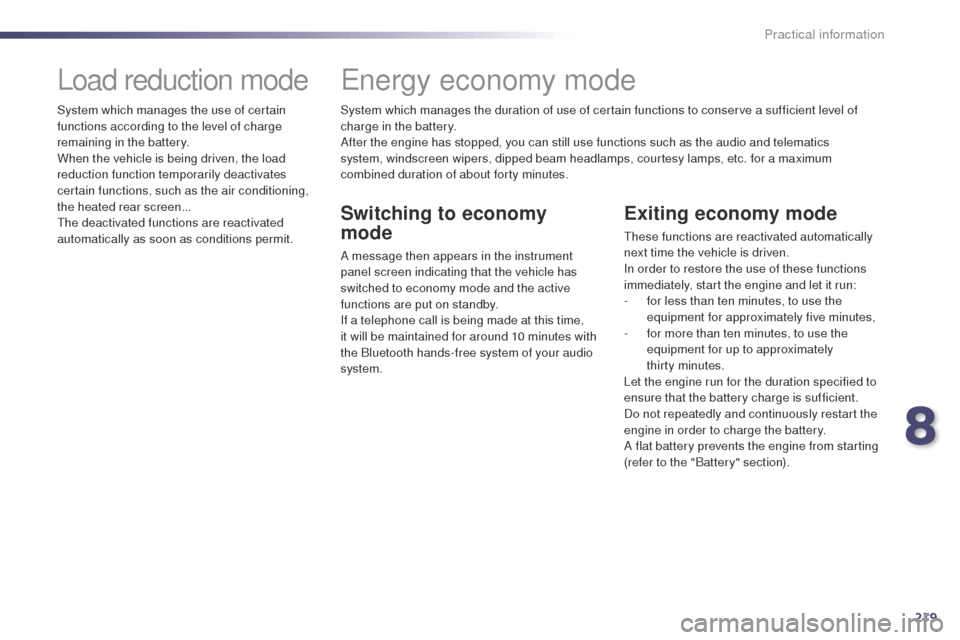
219
508_en_Chap08_info-pratiques_ed02-2014
System which manages the duration of use of certain functions to conserve a sufficient level of
charge in the battery.
After the engine has stopped, you can still use functions such as the audio and telematics
system, windscreen wipers, dipped beam headlamps, courtesy lamps, etc. for a maximum
combined duration of about forty minutes.
energy economy mode
Switching to economy
mode
A message then appears in the instrument
panel screen indicating that the vehicle has
switched to economy mode and the active
functions are put on standby.
If a telephone call is being made at this time,
it will be maintained for around 10 minutes with
the Bluetooth hands-free system of your audio
system.
Exiting economy mode
these functions are reactivated automatically
next time the vehicle is driven.
In order to restore the use of these functions
immediately, start the engine and let it run:
-
f
or less than ten minutes, to use the
equipment for approximately five minutes,
-
f
or more than ten minutes, to use the
equipment for up to approximately
thirty
minutes.
Let the engine run for the duration specified to
ensure that the battery charge is sufficient.
Do not repeatedly and continuously restart the
engine in order to charge the battery.
A flat battery prevents the engine from starting
(refer to the "Battery" section).
Load reduction mode
System which manages the use of certain
functions according to the level of charge
remaining in the battery.
When the vehicle is being driven, the load
reduction function temporarily deactivates
certain functions, such as the air conditioning,
the heated rear screen...
th
e deactivated functions are reactivated
automatically as soon as conditions permit.
8
Practical information
Page 222 of 380
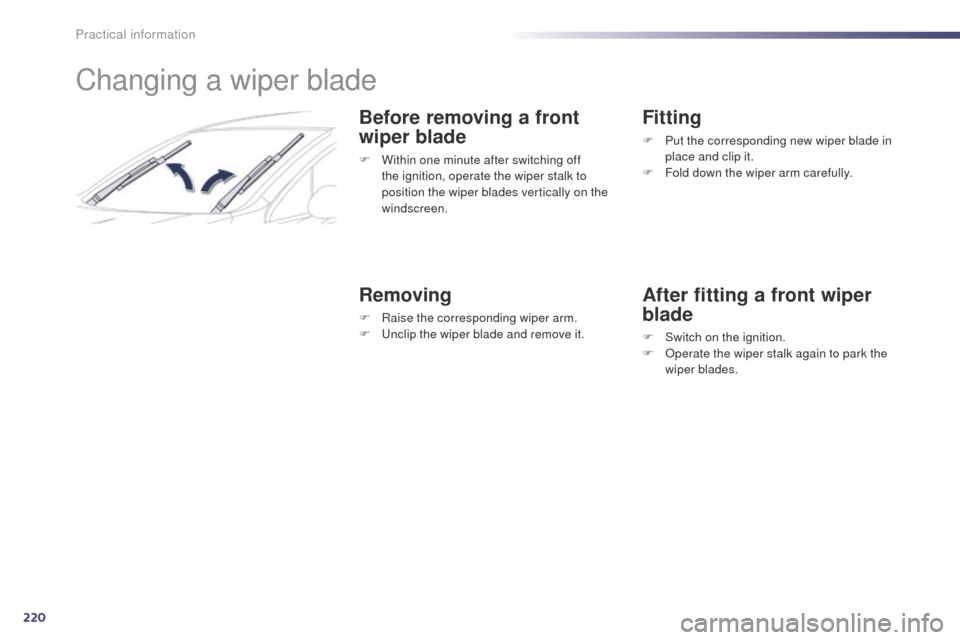
220
508_en_Chap08_info-pratiques_ed02-2014
Changing a wiper blade
Before removing a front
wiper blade
F Within one minute after switching off the ignition, operate the wiper stalk to
position the wiper blades vertically on the
windscreen.
Removing
F Raise the corresponding wiper arm.
F un clip the wiper blade and remove it.
Fitting
F Put the corresponding new wiper blade in place and clip it.
F
F
old down the wiper arm carefully.
After fitting a front wiper
blade
F Switch on the ignition.
F O perate the wiper stalk again to park the
wiper blades.
Practical information
Page 223 of 380
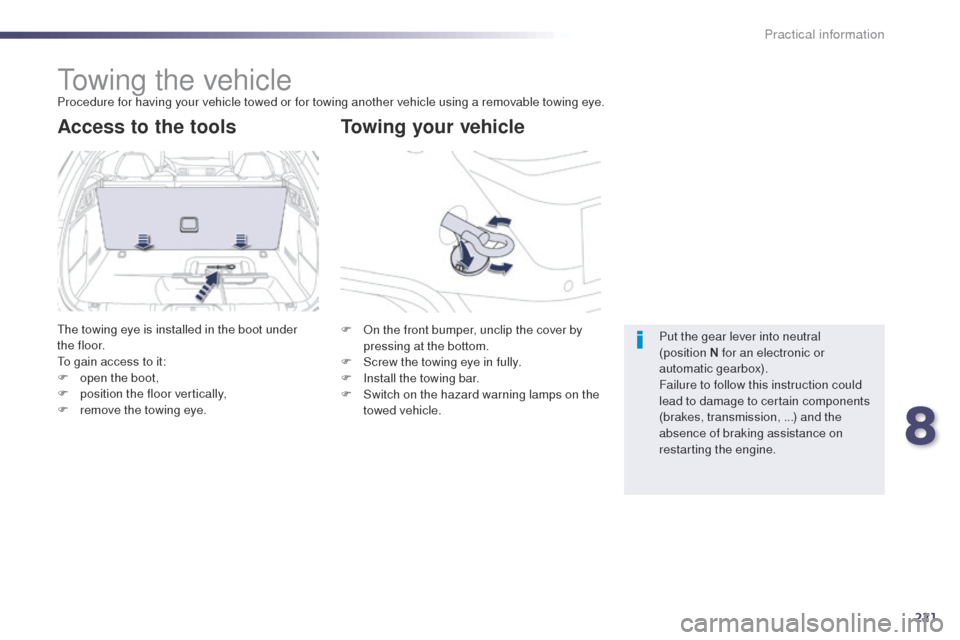
221
508_en_Chap08_info-pratiques_ed02-2014
towing the vehicleProcedure for having your vehicle towed or for towing another vehicle using a removable towing eye.
Towing your vehicle
Access to the tools
the towing eye is installed in the boot under
t h e f l o o r.
to g
ain access to it:
F
o
pen the boot,
F
p
osition the floor vertically,
F
r
emove the towing eye. F
O n the front bumper, unclip the cover by
pressing at the bottom.
F
S
crew the towing eye in fully.
F
I
nstall the towing bar.
F
S
witch on the hazard warning lamps on the
towed vehicle. Put the gear lever into neutral
(position
N for an electronic or
automatic gearbox).
Failure to follow this instruction could
lead to damage to certain components
(brakes, transmission, ...) and the
absence of braking assistance on
restarting the engine.
8
Practical information
Page 224 of 380
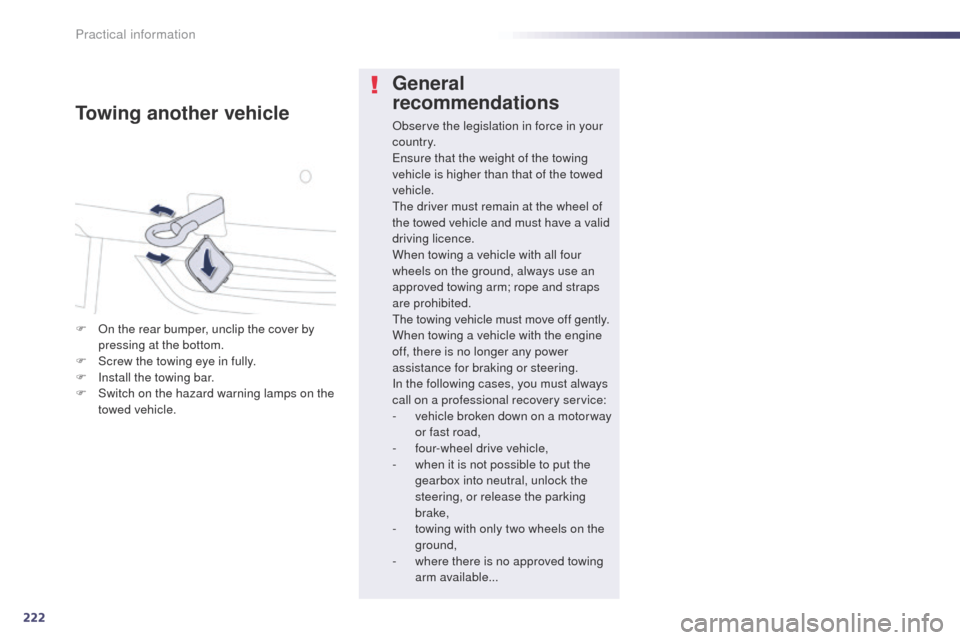
222
508_en_Chap08_info-pratiques_ed02-2014
General
recommendations
Observe the legislation in force in your
c o unt r y.
en
sure that the weight of the towing
vehicle is higher than that of the towed
vehicle.
th
e driver must remain at the wheel of
the towed vehicle and must have a valid
driving licence.
When towing a vehicle with all four
wheels on the ground, always use an
approved towing arm; rope and straps
are prohibited.
th
e towing vehicle must move off gently.
When towing a vehicle with the engine
off, there is no longer any power
assistance for braking or steering.
In the following cases, you must always
call on a professional recovery service:
-
v
ehicle broken down on a motor way
or fast road,
-
f
our-wheel drive vehicle,
-
w
hen it is not possible to put the
gearbox into neutral, unlock the
steering, or release the parking
brake,
-
t
owing with only two wheels on the
ground,
-
w
here there is no approved towing
arm available...Towing another vehicle
F On the rear bumper, unclip the cover by pressing at the bottom.
F
S
crew the towing eye in fully.
F
I
nstall the towing bar.
F
S
witch on the hazard warning lamps on the
towed vehicle.
Practical information
Page 225 of 380
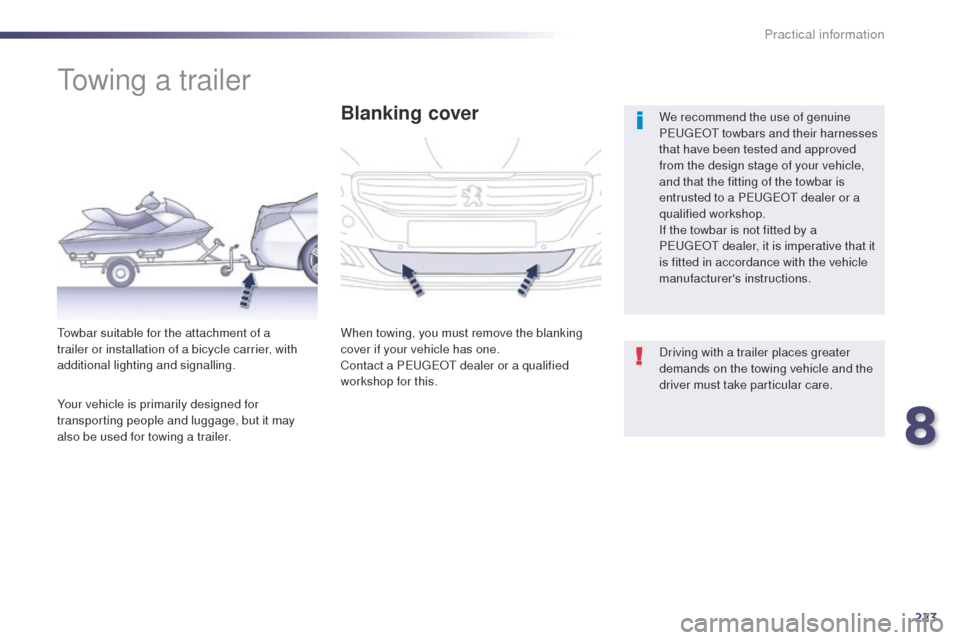
223
508_en_Chap08_info-pratiques_ed02-2014
towing a trailer
We recommend the use of genuine
PeugeOt towbars and their harnesses
that have been tested and approved
from the design stage of your vehicle,
and that the fitting of the towbar is
entrusted to a P
e
uge
Ot
dealer or a
qualified workshop.
If the towbar is not fitted by a
P
e
uge
Ot
dealer, it is imperative that it
is fitted in accordance with the vehicle
manufacturer's instructions.
to
wbar suitable for the attachment of a
trailer or installation of a bicycle carrier, with
additional lighting and signalling.Blanking cover
When towing, you must remove the blanking
cover if your vehicle has one.
Contact a P
e
uge
Ot
dealer or a qualified
workshop for this. Driving with a trailer places greater
demands on the towing vehicle and the
driver must take particular care.
Your vehicle is primarily designed for
transporting people and luggage, but it may
also be used for towing a trailer.
8
Practical information
Page 226 of 380
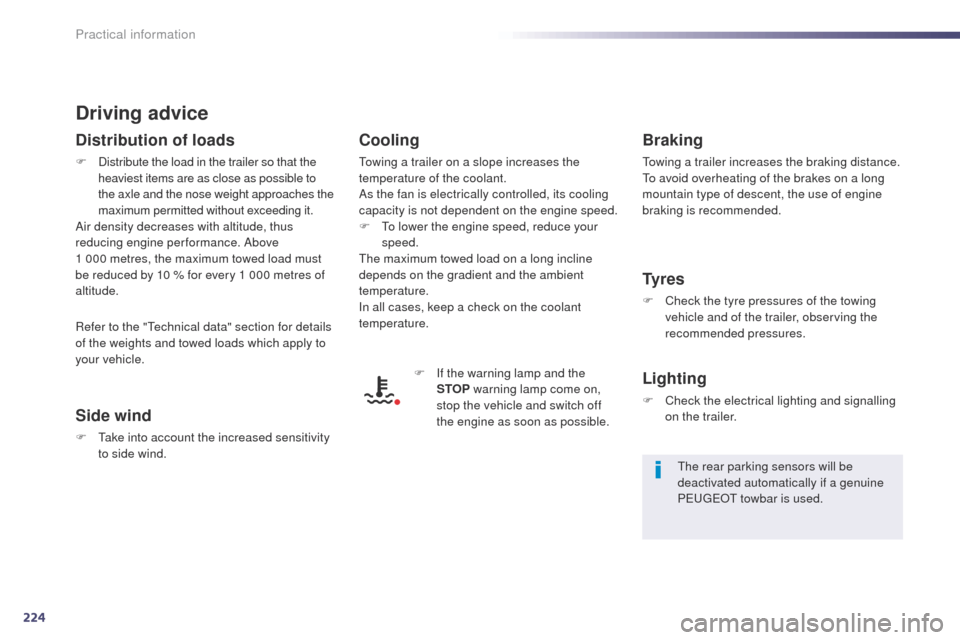
224
508_en_Chap08_info-pratiques_ed02-2014
Driving advice
Distribution of loads
F Distribute the load in the trailer so that the heaviest items are as close as possible to
the axle and the nose weight approaches the
maximum permitted without exceeding it.
Air density decreases with altitude, thus
reducing engine performance. Above
1
000 metres, the maximum towed load must
be reduced by 10
% for every 1 000 metres of
altitude.
Side wind
F take into account the increased sensitivity to side wind.
Cooling
towing a trailer on a slope increases the
temperature of the coolant.
As the fan is electrically controlled, its cooling
capacity is not dependent on the engine speed.
F
t
o l
ower the engine speed, reduce your
speed.
th
e maximum towed load on a long incline
depends on the gradient and the ambient
temperature.
In all cases, keep a check on the coolant
temperature.
F
I
f the warning lamp and the
STOP warning lamp come on,
stop the vehicle and switch off
the engine as soon as possible.
Braking
towing a trailer increases the braking distance.to a void overheating of the brakes on a long
mountain type of descent, the use of engine
braking is recommended.
Ty r e s
F Check the tyre pressures of the towing vehicle and of the trailer, observing the
recommended pressures.
Lighting
F Check the electrical lighting and signalling on the trailer.
th
e rear parking sensors will be
deactivated automatically if a genuine
P
e
uge
Ot
towbar is used.
Refer to the "
te
chnical data" section for details
of the weights and towed loads which apply to
your vehicle.
Practical information
Page 227 of 380
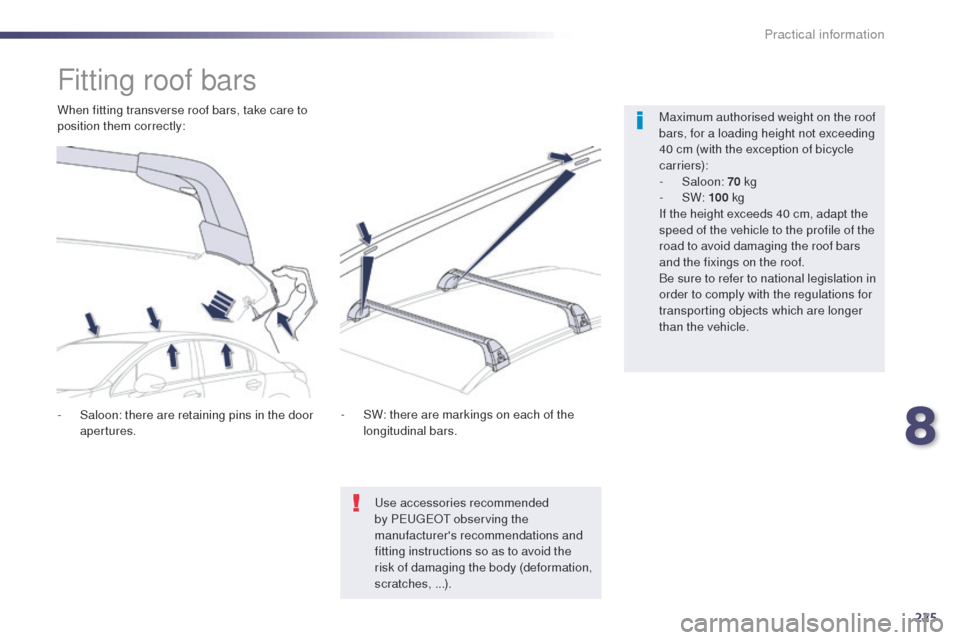
225
508_en_Chap08_info-pratiques_ed02-2014
Fitting roof bars
Maximum authorised weight on the roof
bars, for a loading height not exceeding
40 cm (with the exception of bicycle
c a r r i e r s):
-
Saloon: 70 kg
-
SW: 100 kg
If the height exceeds 40 cm, adapt the
speed of the vehicle to the profile of the
road to avoid damaging the roof bars
and the fixings on the roof.
Be sure to refer to national legislation in
order to comply with the regulations for
transporting objects which are longer
than the vehicle.
-
S
aloon: there are retaining pins in the door
apertures.
When fitting transverse roof bars, take care to
position them correctly:
-
S
W: there are markings on each of the
longitudinal bars.
us
e accessories recommended
by P
e
uge
Ot
observing the
manufacturer's recommendations and
fitting instructions so as to avoid the
risk of damaging the body (deformation,
scratches, ...).
8
Practical information
Page 228 of 380
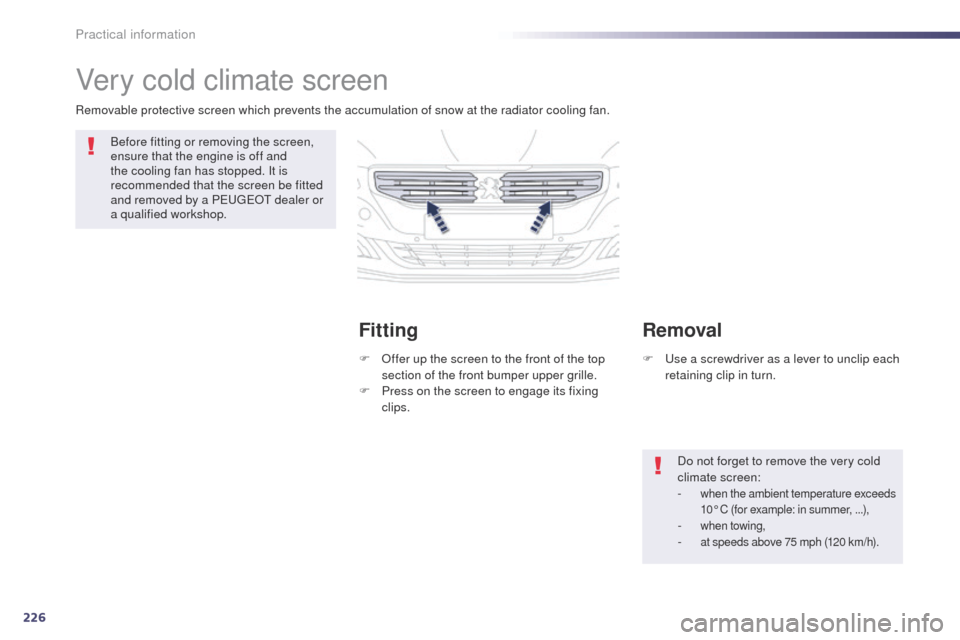
226
508_en_Chap08_info-pratiques_ed02-2014
Very cold climate screen
Before fitting or removing the screen,
ensure that the engine is off and
the cooling fan has stopped. It is
recommended that the screen be fitted
and removed by a P
e
uge
Ot
dealer or
a qualified workshop.
Do not forget to remove the very cold
climate screen:
-
when the ambient temperature exceeds
10° C (for example: in summer, ...),
- when towing,- at speeds above 75 mph (120 km/h).
Removable protective screen which prevents the accumulation of snow at the radiator cooling fan.
Fitting
F Offer up the screen to the front of the top section of the front bumper upper grille.
F
P
ress on the screen to engage its fixing
clips.
Removal
F use a screwdriver as a lever to unclip each retaining clip in turn.
Practical information
Page 229 of 380
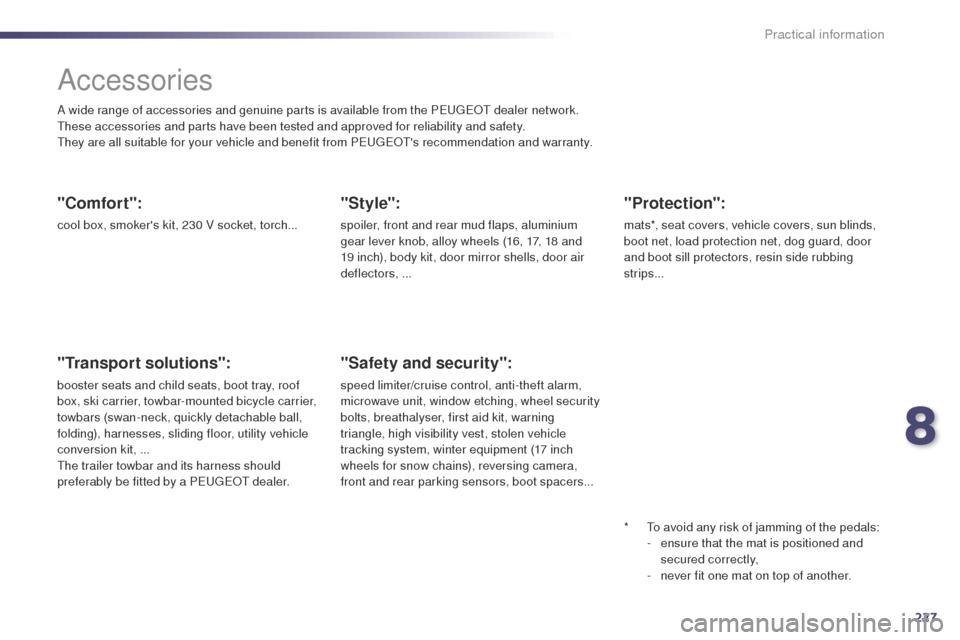
227
508_en_Chap08_info-pratiques_ed02-2014
Accessories
A wide range of accessories and genuine parts is available from the PeugeOt dealer network.th
ese accessories and parts have been tested and approved for reliability and safety.
th
ey are all suitable for your vehicle and benefit from P
e
uge
Ot'
s recommendation and warranty.
"Comfort":
cool box, smoker's kit, 230 V socket, torch...
"Transport solutions":
booster seats and child seats, boot tray, roof
box, ski carrier, towbar-mounted bicycle carrier,
towbars (swan-neck, quickly detachable ball,
folding), harnesses, sliding floor, utility vehicle
conversion kit, ...
th
e trailer towbar and its harness should
preferably be fitted by a P
e
uge
Ot
dealer.
"Style":
spoiler, front and rear mud flaps, aluminium
gear lever knob, alloy wheels (16, 17, 18 and
19 inch), body kit, door mirror shells, door air
deflectors, ...
*
t
o a
void any risk of jamming of the pedals:
-
e
nsure that the mat is positioned and
secured correctly,
-
n
ever fit one mat on top of another.
"Safety and security":
speed limiter/cruise control, anti-theft alarm,
microwave unit, window etching, wheel security
bolts, breathalyser, first aid kit, warning
triangle, high visibility vest, stolen vehicle
tracking system, winter equipment (17 inch
wheels for snow chains), reversing camera,
front and rear parking sensors, boot spacers...
"Protection":
mats*, seat covers, vehicle covers, sun blinds,
boot net, load protection net, dog guard, door
and boot sill protectors, resin side rubbing
strips...
8
Practical information
Page 230 of 380
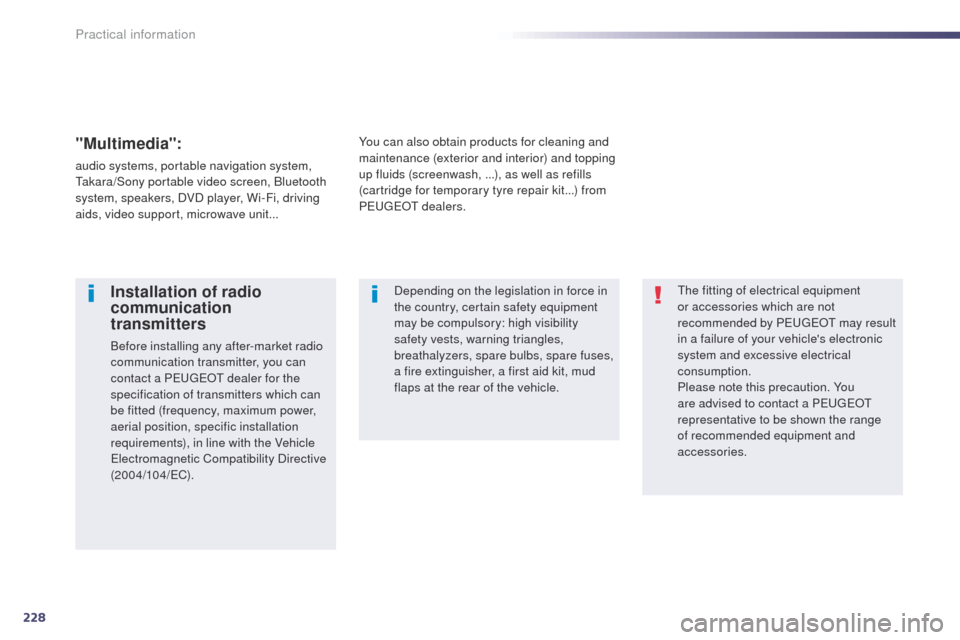
228
508_en_Chap08_info-pratiques_ed02-2014
the fitting of electrical equipment
or accessories which are not
recommended by P
e
uge
Ot
may result
in a failure of your vehicle's electronic
system and excessive electrical
consumption.
Please note this precaution. You
are advised to contact a P
e
uge
Ot
representative to be shown the range
of recommended equipment and
accessories.Installation of radio
communication
transmitters
Before installing any after-market radio
communication transmitter, you can
contact a P
e
uge
Ot
dealer for the
specification of transmitters which can
be fitted (frequency, maximum power,
aerial position, specific installation
requirements), in line with the Vehicle
el
ectromagnetic Compatibility Directive
(2004/104/
eC
). Depending on the legislation in force in
the country, certain safety equipment
may be compulsory: high visibility
safety vests, warning triangles,
breathalyzers, spare bulbs, spare fuses,
a fire extinguisher, a first aid kit, mud
flaps at the rear of the vehicle.
You can also obtain products for cleaning and
maintenance (exterior and interior) and topping
up fluids (screenwash, ...), as well as refills
(cartridge for temporary tyre repair kit...) from
P
e
uge
Ot d
ealers.
"Multimedia":
audio systems, portable navigation system, ta
kara/Sony portable video screen, Bluetooth
system, speakers, DVD player, Wi-Fi, driving
aids, video support, microwave unit...
Practical information